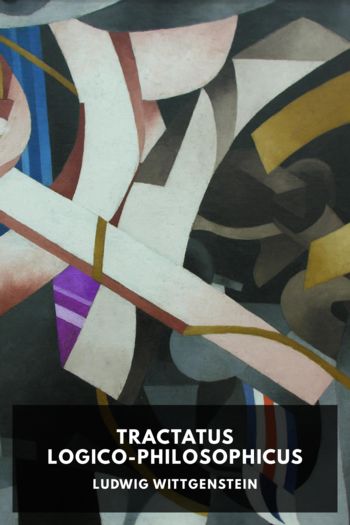Tractatus Logico-Philosophicus - Ludwig Wittgenstein (top 10 ebook reader TXT) 📗

- Author: Ludwig Wittgenstein
Book online «Tractatus Logico-Philosophicus - Ludwig Wittgenstein (top 10 ebook reader TXT) 📗». Author Ludwig Wittgenstein
It has been shown by Dr. Sheffer (Trans. Am. Math. Soc., Vol. XIV pp. 481–488) that all truth-functions of a given set of propositions can be constructed out of either of the two functions “not-p or not-q” or “not-p and not-q”. Wittgenstein makes use of the latter, assuming a knowledge of Dr. Sheffer’s work. The manner in which other truth-functions are constructed out of “not-p and not-q” is easy to see. “Not-p and not-p” is equivalent to “not-p”, hence we obtain a definition of negation in terms of our primitive function: hence we can define “p or q”, since this is the negation of “not-p and not-q”, i.e. of our primitive function. The development of other truth-functions out of “not-p” and “p or q” is given in detail at the beginning of Principia Mathematica. This gives all that is wanted when the propositions which are arguments to our truth-function are given by enumeration. Wittgenstein, however, by a very interesting analysis succeeds in extending the process to general propositions, i.e. to cases where the propositions which are arguments to our truth-function are not given by enumeration but are given as all those satisfying some condition. For example, let fx be a propositional function (i.e. a function whose values are propositions), such as “x is human”—then the various values of fx form a set of propositions. We may extend the idea “not-p and not-q” so as to apply to the simultaneous denial of all the propositions which are values of fx. In this way we arrive at the proposition which is ordinarily represented in mathematical logic by the words “fx is false for all values of x”. The negation of this would be the proposition “there is at least one x for which fx is true” which is represented by “(∃x).fx”. If we had started with not-fx instead of fx we should have arrived at the proposition “fx is true for all values of x” which is represented by “(x).fx”. Wittgenstein’s method of dealing with general propositions [i.e. “(x).fx” and “(∃x).fx”] differs from previous methods by the fact that the generality comes only in specifying the set of propositions concerned, and when this has been done the building up of truth-functions proceeds exactly as it would in the case of a finite number of enumerated arguments p,q,r,….
Mr. Wittgenstein’s explanation of his symbolism at this point is not quite fully given in the text. The symbol he uses is [p‾,ξ‾,N(ξ‾)]. The following is the explanation of this symbol:
p‾ stands for all atomic propositions.
ξ‾ stands for any set of propositions.
N(ξ‾) stands for the negation of all the propositions making up ξ‾.
The whole symbol [p‾,ξ‾,N(ξ‾)] means whatever can be obtained by taking any selection of atomic propositions, negating them all, then taking any selection of the set of propositions now obtained, together with any of the originals—and so on indefinitely. This is, he says, the general truth-function and also the general form of proposition. What is meant is somewhat less complicated than it sounds. The symbol is intended to describe a process by the help of which, given the atomic propositions, all others can be manufactured. The process depends upon:
Sheffer’s proof that all truth-functions can be obtained out of simultaneous negation, i.e. out of “not-p and not-q”;
Mr. Wittgenstein’s theory of the derivation of general propositions from conjunctions and disjunctions;
The assertion that a proposition can only occur in another proposition as argument to a truth-function. Given these three foundations, it follows that all propositions which are not atomic can be derived from such as are, by a uniform process, and it is this process which is indicated by Mr. Wittgenstein’s symbol.
From this uniform method of construction we arrive at an amazing simplification of the theory of inference, as well as a definition of the sort of propositions that belong to logic. The method of generation which has just been described, enables Wittgenstein to say that all propositions can be constructed in the above manner from atomic propositions, and in this way the totality of propositions is defined. (The apparent exceptions which we mentioned above are dealt with in a manner which we shall consider later.) Wittgenstein is enabled to assert that propositions are all that follows from the totality of atomic propositions (together with the fact that it is the totality of them); that a proposition is always a truth-function of atomic propositions; and that if p follows from q the meaning of p is contained in the meaning of q, from which of course it results that nothing can be deduced from an atomic proposition. All the propositions of logic, he maintains, are tautologies, such, for example, as “p or not p”.
The fact that nothing can be deduced from an atomic proposition has interesting applications, for example, to causality. There cannot, in Wittgenstein’s logic, be any such thing as a causal nexus. “The events of the future,” he says, “cannot be inferred from those of the present.





Comments (0)